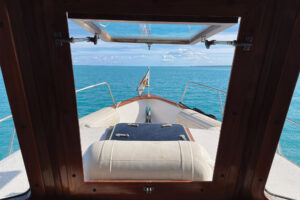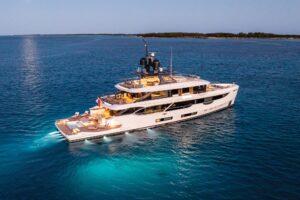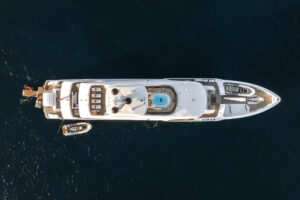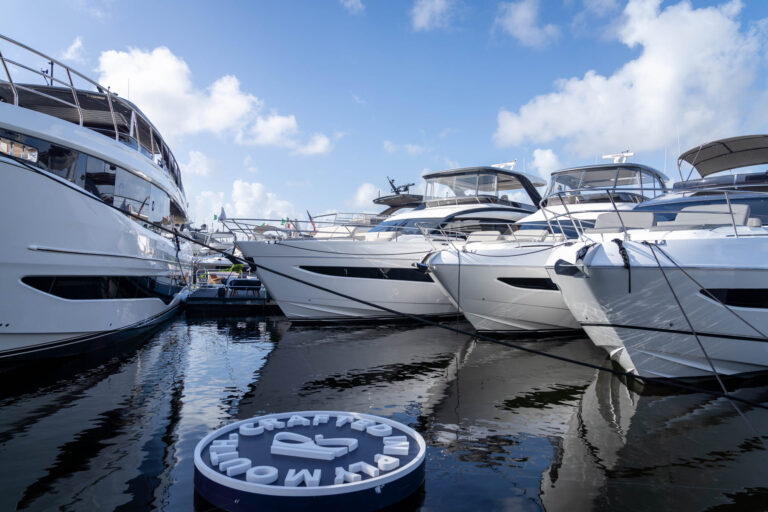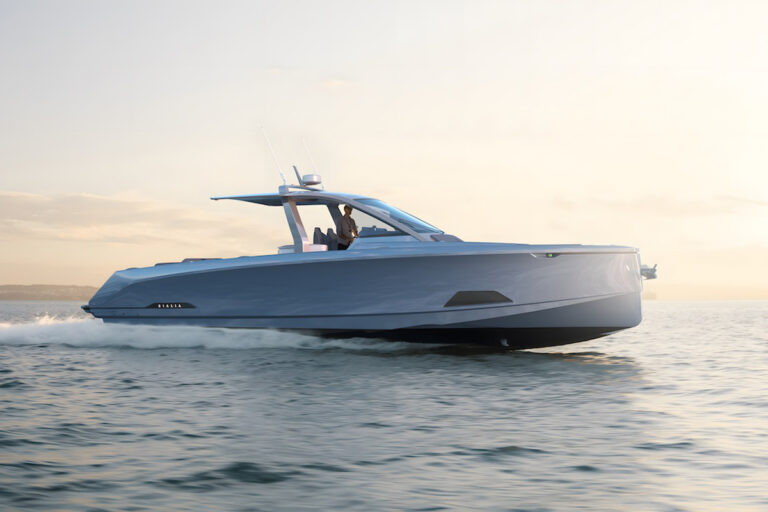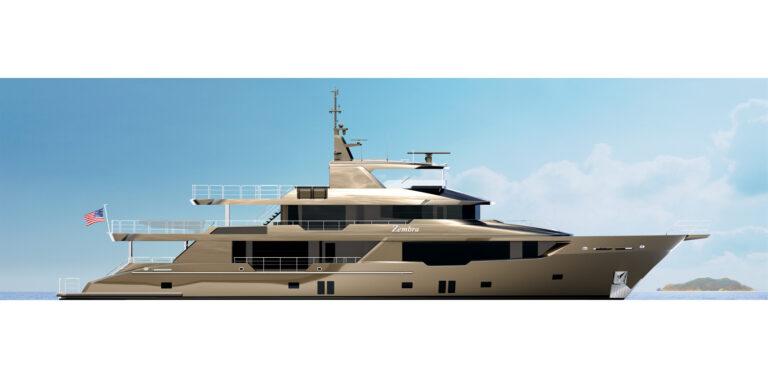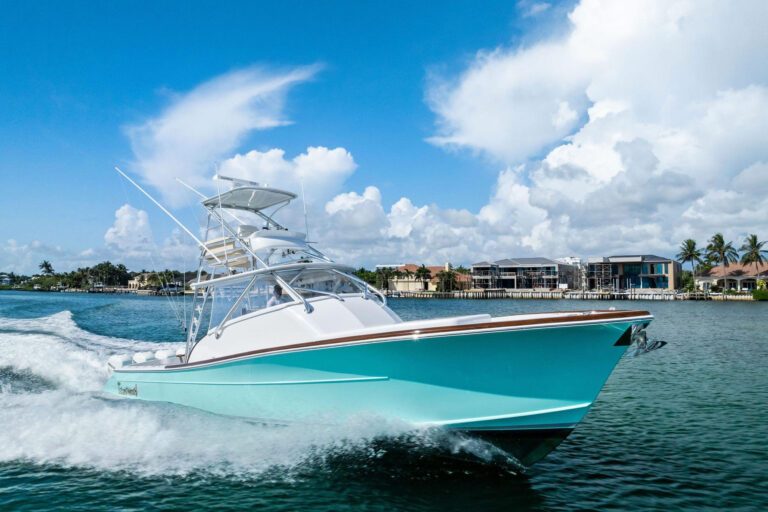Fortim, Brazil, is a small, sleepy fishing village on the sandy northeast coast of Brazil, about 920 coastal miles southeast from the entrance to the Amazon River. At first it seems to have no claim to fame other than that it typifies the dozens of small towns that dot the long Brazilian coastline. The only notable feature is that it’s located a couple of miles inland on the banks of the Jaguaribe River, and rich Brazilians looking for vacation spots have built elaborate luxury homes on the riverbank, as if Fortim has more to offer than electricity and fish.
My own interest in Fortim was born when I arrived in the city of Fortaleza, 80 miles west of this quiet destination, to check out a Buccaneer 65, an ocean-going trawler built in Fortaleza. I had asked Janusz Leczynski, the Polish-born general manager of Buccaneer, to take me to an interesting place where I could take some photos of the boat. The Buccaneer is meant for world-traveling adventurers, a heavy-duty fortress of a yacht with a 10-foot-high bow and a nearly 4,000-mile cruising range. Moseying down the coast of Brazil seemed an ideal way to experience this vessel.
After I arrived at 2 a.m., Janusz and crew immediately wanted to leave, so an hour later we weighed anchor and headed out. I headed for the master stateroom to get some sleep.
I awoke rolling around on the king-size bed and I went up on deck to see that the wind had kicked up seas to an ugly eight-foot chop directly on our bow. The all-aluminum Buccaneer seemed right at home in these conditions. With a full-displacement hull, large stabilizers, hard chines and a super-wide, 19-foot beam, the boat rode the seas soft and firm. No pounding, no shuddering, just a rocking-chair march into the black void. Nonetheless, I was still glad I’d taken some Dramamine.
It was mid-morning before the seas started to calm a bit. I arose and went topside, startled to see an opaque green sea, a dusty blue sky and a coastline more resembling the Sahara than the jungle I’d been expecting. We were cruising along at only six knots, about half the yacht’s top speed of 12 knots (it cruises at 10 knots). Janusz explained that the mouth of the Jaguaribe River was a bit tricky and we didn’t want to arrive before high tide-around 2 p.m.
Our real guide this day was a Brazilian named Moacir Lopes, a husky local captain with a round, weathered face and wavy, dark hair, who spoke no English. When we finally arrived outside the river I saw what Janusz was talking about-heavy surf stretching almost all the way across the mouth. Here and there we could see quiet spots between sandy shoals which nearly broke the surface. Lopes idled back and forth, searching for the best way through for the Buccaneer, which draws a relatively shallow five feet fully loaded.
On the way down I had seen a number of gaff-rigged, Brazilian fishing boats called jamgangas. Each one was little more than a working platform with a mast stuck on it, and the catch carried on deck was subsistence only, mostly snapper and other reef fish. As we searched for a good route, a group of jamgangas appeared and headed through the surf into the river. Lopes gunned the twin Caterpillar diesels and we began to follow them.
On the bridge Janusz peered anxiously ahead. A lot was riding on us making it through-the shoals could easily derail the promising beginning of Buccaneer Yachts. Not only would it have spoiled a good Yachting article, but this was hull number one, the company’s only real yacht. As soon as this trip was over it was scheduled to begin a three-week voyage to the Ft. Lauderdale Boat Show for the official debut.
The surf broke nearby on both sides as we idled into the entrance behind one of the jamgangas. The fisherman waved and pointed out the best way. Suddenly we felt a lurch-the yacht had hit the sandy bottom. But the bump didn’t slow the trawler much, and in a moment we were on our way again. There was no vibration, no apparent problem. Our keel protruded several inches below the props and nothing had been damaged. As the water quieted, we glided upstream to Fortim.
After we anchored off Fortim’s rickety waterfront, I took the opportunity to inspect the yacht more thoroughly. The interior arrangement is sensible and takes full advantage of the extra-wide beam to provide roominess found in much larger yachts. The lower deck, accessed through stairs to a small foyer, sleeps six comfortably. I’ve seen master staterooms on much larger yachts that seemed smaller than this full-width room, which contained four hanging lockers, counters on both sides and a plasma television. Only the bulkhead separates the master from the engine room, but the engine noise was very acceptable, thanks to vibration dampeners and other soundproofing in the engine room. Forward of the master is a small portside stateroom with twin over/under bunks. A VIP stateroom is further forward and includes a queen-size bed, more hanging lockers and another plasma television. Aft of the spacious, well-organized engine room is a berth for a single crewman or a seventh guest.
With such a wide beam, the main deck is big enough to hold both wide-side decks and a spacious saloon. This saloon includes a U-shaped settee and coffee table to port opposite the entertainment counter to starboard. A bar with four mounted stools lines the forward wall. (Janusz said Buccaneer can customize the saloon and other interior spaces to satisfy a client’s preferences.) An enclosed galley, accessed via the starboard foyer leading to the pilothouse, is just forward of the saloon. Guests can dine either casually in the saloon or around the oval table on the aft deck, which seats eight quite comfortably.
The aft deck also includes a refrigerator, stowage space on either side of the saloon door, and a stairwell to the bridge deck located forward to port. A portside stairwell on the aft deck leads to the bridge deck. The main features here are a semi-circular seating area with a large coffee table on the centerline, plus two cushioned couches both sides of the bridge helm. Astern on the bridge deck is a hoist and an inflatable tender.
What makes the Buccaneer a truly global yacht, however, is the extra attention to the onboard systems. A few items worth mentioning: Alpha Lavals, high-end fuel filters normally seen on much larger boats. Much of the piping is corrosion-proof cupra-nickel or stainless steel. And the fuel tanks hold nearly 3,200 gallons, with an extra 760-gallon tank under the swim platform, giving the 205 hp diesels enough fuel for transoceanic cruises.
A couple of hours before sunset I went ashore to explore Fortim and take some photos. Janusz brought me in the tender to what seemed to be the only inviting dock in the harbor, a fluorescent-lit restaurant where a dozen Brazilian men stared sullenly while I scrambled up the stairs.
Like most small South American towns, Fortim hasn’t changed much in the past century. Painted advertising and graffiti mark the large blank walls of many single-story homes and businesses. At night the streets are awkwardly lit by orange streetlights; bright fluorescents, flood out of open windows and doorways. A car or a motorcycle would zoom by occasionally, and a few pedestrians ambled along the raised sidewalks, but the streets were largely silent. Small groups of people clustered in front of their stores or homes, where they had raised the practice of sitting to an art form.
A group of men played dominos on the sidewalk next to the main town square, ignoring me as I took some photos. As the sun set, school let out and dozens of uniformed children livened up the otherwise placid streets. A few of them picked up a soccer ball and started tossing it around, and a crowd gathered to watch. Down another street a craftsman was shaping a sailboat mast, drawing a group of onlookers.
That evening we went into town for dinner. A scouting party had learned there were only two restaurants nearby, but there were several others a few miles away on the outskirts. We chose the one I had used as a dock, and we were the only patrons. The waiter brought out on plates a meager selection of fish to choose from, plus a few small lobster tails.
Lopes was worried we might not get out of Fortim the next day. The high tide was at dawn. To make it out we would have to leave then or wait for the next tide that afternoon. Having seen it all at Fortim, we went to bed planning to weigh anchor before sunrise.
The next morning there was a loud knock on the stateroom door. “We have a problem, said the mate. “It looks like we’ve lost the high tide. I had wanted to shoot some photos, so I jumped into the tender while the crew quickly raised the anchor and then desperately raced the lowering tide. In minutes we were moving out to the river’s mouth. Already the tide had gone down a foot.
Again the tension rose as the Buccaneer 65 approached the mouth. “The captain’s not taking the same route, Janusz said, sounding alarmed. “He should be over there, pointing to a quiet spot in the approaching surf. Lopes said nothing.
Several jamgangas had already set sail ahead of us and we dropped astern of a slow workboat that was also heading out. This time we trailed the workboat only part of the way, breaking away to zigzag on our own through the brown water. Waves were breaking over shallow places only yards from our course. A four-foot chop rocked the bow up and down, but this time the boat didn’t strike bottom. A few minutes later we were through and the crew high-fived their success.
This is what adventure cruising is all about: Finding new, unexplored places, matching wits with the sea and the environment, coming home with stories of fascinating quests and close escapes. And this is what the Buccaneer was designed for.
The trip back to Fortaleza was much easier. The following seas were not as bad and the Buccaneer, this time traveling nearly cruising speed, was able to use the stabilizers more effectively. The yacht was still not finished-there was a long punch list that had to be completed before the boat show. But it was easy to see that in a segment of the oceangoing trawler market that’s growing increasingly more crowded, the Buccaneer is a very worthy entrant.
Contact: Buccaneer Cruising Yachts, (954) 713-0372; www.buccaneercy.com

